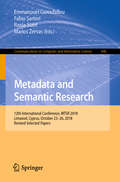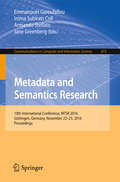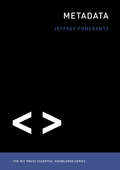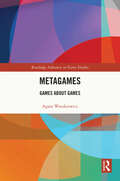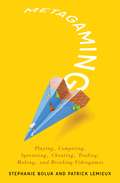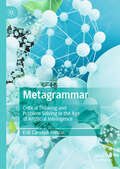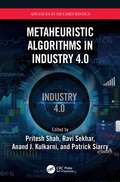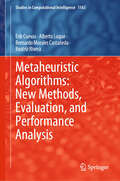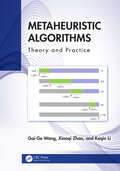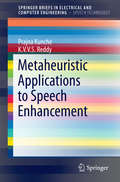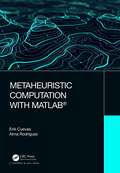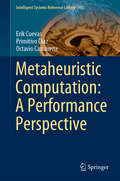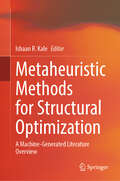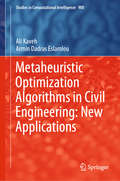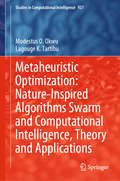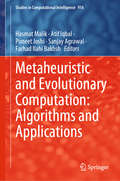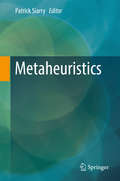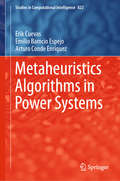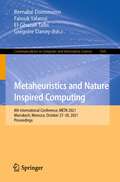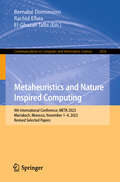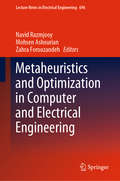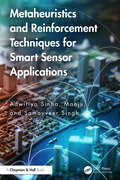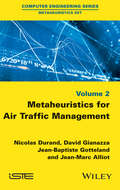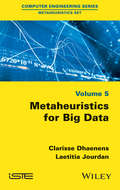- Table View
- List View
Metadata and Semantic Research: Third International Conference, Mtsr 2009, Milan, Italy, October 1-2, 2009. Proceedings (Communications in Computer and Information Science #46)
by Emmanouel Garoufallou Rania Siatri Fabio Sartori Marios ZervasThis book constitutes the thoroughly refereed proceedings of the 12th International Conference on Metadata and Semantic Research, MTSR 2018, held in Limassol, Cyprus, on October 23-26, 2018. The 19 full and 16 short papers presented were carefully reviewed and selected from 77 submissions. The papers are organized in topical sections on metadata, linked data, semantics, ontologies and SKOS; digital libraries, information retrieval, big, linked, social and open data; cultural collections and applications; Knowledge IT Artifacts (KITA) in professional communities and aggregations; Digital Humanities and Digital Curation (DHC); European and national projects; agriculture, food and environment; open repositories, research information systems and data infrastructures.
Metadata and Semantics Research
by Emmanouel Garoufallou Imma Subirats Coll Armando Stellato Jane GreenbergThis book constitutes the refereed proceedings of the 9th Metadata and Semantics Research Conference, MTSR 2015, held in Manchester, UK, in September 2015. The 35 full papers and 3 short papers presented together with 2 poster papers were carefully reviewed and selected from 76 submissions. The papers are organized in several sessions and tracks: general track on ontology evolution, engineering, and frameworks, semantic Web and metadata extraction, modelling, interoperability and exploratory search, data analysis, reuse and visualization; track on digital libraries, information retrieval, linked and social data; track on metadata and semantics for open repositories, research information systems and data infrastructure; track on metadata and semantics for agriculture, food and environment; track on metadata and semantics for cultural collections and applications; track on European and national projects.
Metadata and Semantics Research: 10th International Conference, MTSR 2016, Göttingen, Germany, November 22-25, 2016, Proceedings (Communications in Computer and Information Science #672)
by Emmanouel Garoufallou, Imma Subirats Coll, Armando Stellato and Jane GreenbergThis book constitutes the refereed proceedings of the 10th Metadata and Semantics Research Conference, MTSR 2016, held in Göttingen, Germany, in November 2016. The 26 full papers and 6 short papers presented were carefully reviewed and selected from 67 submissions. The papers are organized in several sessions and tracks: Digital Libraries, Information Retrieval, Linked and Social Data, Metadata and Semantics for Open Repositories, Research Information Systems and Data Infrastructures, Metadata and Semantics for Agriculture, Food and Environment, Metadata and Semantics for Cultural Collections and Applications, European and National Projects.
Metadata: The Mit Press Essential Knowledge Series (The MIT Press Essential Knowledge series)
by Jeffrey PomerantzEverything we need to know about metadata, the usually invisible infrastructure for information with which we interact every day. When “metadata” became breaking news, appearing in stories about surveillance by the National Security Agency, many members of the public encountered this once-obscure term from information science for the first time. Should people be reassured that the NSA was “only” collecting metadata about phone calls—information about the caller, the recipient, the time, the duration, the location—and not recordings of the conversations themselves? Or does phone call metadata reveal more than it seems? In this book, Jeffrey Pomerantz offers an accessible and concise introduction to metadata.In the era of ubiquitous computing, metadata has become infrastructural, like the electrical grid or the highway system. We interact with it or generate it every day. It is not, Pomerantz tell us, just “data about data.” It is a means by which the complexity of an object is represented in a simpler form. For example, the title, the author, and the cover art are metadata about a book. When metadata does its job well, it fades into the background; everyone (except perhaps the NSA) takes it for granted.Pomerantz explains what metadata is, and why it exists. He distinguishes among different types of metadata—descriptive, administrative, structural, preservation, and use—and examines different users and uses of each type. He discusses the technologies that make modern metadata possible, and he speculates about metadata's future. By the end of the book, readers will see metadata everywhere. Because, Pomerantz warns us, it's metadata's world, and we are just living in it.
Metagames: Games about Games (ISSN)
by Agata WaszkiewiczMetagames: Games about Games scrutinizes how various meta devices, such as breaking the fourth wall and unreliable narrator, change and adapt when translated into the uniquely interactive medium of digital games.Through its theoretical analyses and case studies, the book shows how metafictional experimentation can be used to both challenge and push the boundaries of what a game is and what a player’s role is in play, and to raise more profound topics such as those describing experiences of people of oppressed identities. The book is divided into six chapters that deal with the following meta devices: breaking the fourth wall, hypermediation, unreliable narrator, abusive game design, fragmentation, and parody.The book will predominantly interest scholars and students of media studies and game studies as it continues discourses held in the discipline regarding the metareferential character of digital games.
Metagaming: Playing, Competing, Spectating, Cheating, Trading, Making, and Breaking Videogames (Electronic Mediations #53)
by Stephanie Boluk Patrick LeMieuxThe greatest trick the videogame industry ever pulled was convincing the world that videogames were games rather than a medium for making metagames. Elegantly defined as &“games about games,&” metagames implicate a diverse range of practices that stray outside the boundaries and bend the rules: from technical glitches and forbidden strategies to Renaissance painting, algorithmic trading, professional sports, and the War on Terror. In Metagaming, Stephanie Boluk and Patrick LeMieux demonstrate how games always extend beyond the screen, and how modders, mappers, streamers, spectators, analysts, and artists are changing the way we play.Metagaming uncovers these alternative histories of play by exploring the strange experiences and unexpected effects that emerge in, on, around, and through videogames. Players puzzle through the problems of perspectival rendering in Portal, perform clandestine acts of electronic espionage in EVE Online, compete and commentate in Korean StarCraft, and speedrun The Legend of Zelda in record times (with or without the use of vision). Companies like Valve attempt to capture the metagame through international e-sports and online marketplaces while the corporate history of Super Mario Bros. is undermined by the endless levels of Infinite Mario, the frustrating pranks of Asshole Mario, and even Super Mario Clouds, a ROM hack exhibited at the Whitney Museum of American Art.One of the only books to include original software alongside each chapter, Metagaming transforms videogames from packaged products into instruments, equipment, tools, and toys for intervening in the sensory and political economies of everyday life. And although videogames conflate the creativity, criticality, and craft of play with the act of consumption, we don&’t simply play videogames—we make metagames.
Metagrammar: Critical Thinking and Problem Solving in the Age of Artificial Intelligence
by Erik Camayd-FreixasThis book highlights the grammatical structure of thought and behavior as a blueprint for scientific discovery and innovation. It defines the new concept of metagrammar as the unnoticed transfer of linguistic functions and skills to and from our interaction with the world. Viewing grammar as language engineering, the author argues that metagrammar charts a new mode of reasoning central to critical thinking, problem solving and goal setting in all areas of human endeavor. He shows how metagrammatical structures and genres mediate in the conceptualization of phenomena, as well as in the production of plans, policies, systems and designs. This uniquely human capability is contrasted with mechanistic models in computers and AI that threaten to replace human agency and decision making. This book will be of interest to the educated reader who wants to keep abreast of transformational research in language and cognition as it applies to self and society, current events, digital media and emerging technologies, from artificial intelligence to autonomous systems, from a human-centered perspective. It will be particularly relevant to organizations such as the Modern Languages Association, for its focus on linguistic and narrative theory, cultural studies and critical theory.
Metaheuristic Algorithms in Industry 4.0 (Advances in Metaheuristics)
by Patrick Siarry Anand J. Kulkarni Pritesh Shah Ravi SekharDue to increasing industry 4.0 practices, massive industrial process data is now available for researchers for modelling and optimization. Artificial Intelligence methods can be applied to the ever-increasing process data to achieve robust control against foreseen and unforeseen system fluctuations. Smart computing techniques, machine learning, deep learning, computer vision, for example, will be inseparable from the highly automated factories of tomorrow. Effective cybersecurity will be a must for all Internet of Things (IoT) enabled work and office spaces. This book addresses metaheuristics in all aspects of Industry 4.0. It covers metaheuristic applications in IoT, cyber physical systems, control systems, smart computing, artificial intelligence, sensor networks, robotics, cybersecurity, smart factory, predictive analytics and more. Key features: Includes industrial case studies. Includes chapters on cyber physical systems, machine learning, deep learning, cybersecurity, robotics, smart manufacturing and predictive analytics. surveys current trends and challenges in metaheuristics and industry 4.0. Metaheuristic Algorithms in Industry 4.0 provides a guiding light to engineers, researchers, students, faculty and other professionals engaged in exploring and implementing industry 4.0 solutions in various systems and processes.
Metaheuristic Algorithms: New Methods, Evaluation, and Performance Analysis (Studies in Computational Intelligence #1163)
by Erik Cuevas Alberto Luque Bernardo Morales Castañeda Beatriz RiveraThis book encompasses three distinct yet interconnected objectives. Firstly, it aims to present and elucidate novel metaheuristic algorithms that feature innovative search mechanisms, setting them apart from conventional metaheuristic methods. Secondly, this book endeavors to systematically assess the performance of well-established algorithms across a spectrum of intricate and real-world problems. Finally, this book serves as a vital resource for the analysis and evaluation of metaheuristic algorithms. It provides a foundational framework for assessing their performance, particularly in terms of the balance between exploration and exploitation, as well as their capacity to obtain optimal solutions. Collectively, these objectives contribute to advancing our understanding of metaheuristic methods and their applicability in addressing diverse and demanding optimization tasks. The materials were compiled from a teaching perspective. For this reason, the book is primarily intended for undergraduate and postgraduate students of Science, Electrical Engineering, or Computational Mathematics. Additionally, engineering practitioners who are not familiar with metaheuristic computation concepts will appreciate that the techniques discussed are beyond simple theoretical tools because they have been adapted to solve significant problems that commonly arise in engineering areas.
Metaheuristic Algorithms: Theory and Practice
by Keqin Li Gai-Ge Wang Xiaoqi ZhaoThis book introduces the theory and applications of metaheuristic algorithms. It also provides methods for solving practical problems in such fields as software engineering, image recognition, video networks, and in the oceans.In the theoretical section, the book introduces the information feedback model, learning-based intelligent optimization, dynamic multi-objective optimization, and multi-model optimization. In the applications section, the book presents applications of optimization algorithms to neural architecture search, fuzz testing, oceans, and image processing. The neural architecture search chapter introduces the latest NAS method. The fuzz testing chapter uses multi-objective optimization and ant colony optimization to solve the seed selection and energy allocation problems in fuzz testing. In the ocean chapter, deep learning methods such as CNN, transformer, and attention-based methods are used to describe ENSO prediction and image processing for marine fish identification, and to provide an overview of traditional classification methods and deep learning methods.Rich in examples, this book will be a great resource for students, scholars, and those interested in metaheuristic algorithms, as well as professional practitioners and researchers working on related topics.
Metaheuristic Applications to Speech Enhancement
by Prajna Kunche K. V. V. S. ReddyThis book serves as a basic reference for thoseinterested in the application of metaheuristics to speech enhancement. Themajor goal of the book is to explain the basic concepts of optimization methodsand their use in heuristic optimization in speech enhancement to scientists,practicing engineers, and academic researchers in speech processing. Theauthors discuss why it has been a challenging problem for researchers todevelop new enhancement algorithms that aid in the quality and intelligibilityof degraded speech. They present powerful optimization methods to speechenhancement that can help to solve the noise reduction problems. Readers willbe able to understand the fundamentals of speech processing as well as theoptimization techniques, how the speech enhancement algorithms are implementedby utilizing optimization methods, and will be given the tools to develop newalgorithms. The authors also provide a comprehensive literature surveyregarding the topic.
Metaheuristic Computation with MATLAB®
by Erik Cuevas Alma RodriguezMetaheuristic algorithms are considered as generic optimization tools that can solve very complex problems characterized by having very large search spaces. Metaheuristic methods reduce the effective size of the search space through the use of effective search strategies. Book Features: Provides a unified view of the most popular metaheuristic methods currently in use Includes the necessary concepts to enable readers to implement and modify already known metaheuristic methods to solve problems Covers design aspects and implementation in MATLAB® Contains numerous examples of problems and solutions that demonstrate the power of these methods of optimization The material has been written from a teaching perspective and, for this reason, this book is primarily intended for undergraduate and postgraduate students of artificial intelligence, metaheuristic methods, and/or evolutionary computation. The objective is to bridge the gap between metaheuristic techniques and complex optimization problems that profit from the convenient properties of metaheuristic approaches. Therefore, engineer practitioners who are not familiar with metaheuristic computation will appreciate that the techniques discussed are beyond simple theoretical tools, since they have been adapted to solve significant problems that commonly arise in such areas.
Metaheuristic Computation: A Performance Perspective (Intelligent Systems Reference Library #195)
by Erik Cuevas Primitivo Diaz Octavio CamarenaThis book is primarily intended for undergraduate and postgraduate students of Science, Electrical Engineering, or Computational Mathematics. Metaheuristic search methods are so numerous and varied in terms of design and potential applications; however, for such an abundant family of optimization techniques, there seems to be a question which needs to be answered: Which part of the design in a metaheuristic algorithm contributes more to its better performance? Several works that compare the performance among metaheuristic approaches have been reported in the literature. Nevertheless, they suffer from one of the following limitations: (A)Their conclusions are based on the performance of popular evolutionary approaches over a set of synthetic functions with exact solutions and well-known behaviors, without considering the application context or including recent developments. (B) Their conclusions consider only the comparison of their final results which cannot evaluate the nature of a good or bad balance between exploration and exploitation. The objective of this book is to compare the performance of various metaheuristic techniques when they are faced with complex optimization problems extracted from different engineering domains. The material has been compiled from a teaching perspective.
Metaheuristic Methods for Structural Optimization: A Machine-Generated Literature Overview
by Ishaan R. KaleThis book presents the result of an innovative challenge, to create a systematic literature overview driven by machine-generated content. This machine-generated volume, with chapter introductions by the human expert, of summaries of the existing studies furthers our understanding of the heuristic and metaheuristic optimization methods for structural engineering domain problems. It brings out nature inspired metaheuristic optimization methods such as Genetic Algorithm, Particle Swarm Optimization, Ant Colony Optimization, Cohort Intelligence, Firefly Algorithm, Differential Evolution, Bee Colony, Grey Wolf Optimizer, League Championship Algorithm, Harmony Search Algorithm, Water Cycle Algorithm, Neural Network Algorithm, and its different variations that have been widely used to solve structural engineering problems.This book will be helpful for academicians and researchers in many kinds such as surveys of nature inspired optimization algorithms for structural optimization, its applicability for solving single objective and multi-objective structural engineering problems, constraint handling, solution quality, challenges, opportunities, key features, and limitations.Questions and related keywords were prepared for the machine to query, discover, collate and structure by Artificial Intelligence (AI) clustering. The AI-based approach seemed especially suitable to provide an innovative perspective as the topics are indeed both complex, interdisciplinary and multidisciplinary. Springer Nature has published much on these topics in its journals over the years, so the challenge was for the machine to identify the most relevant content and present it in a structured way that the reader would find useful. The automatically generated literature summaries in this book are intended as a springboard to further discoverability. They are particularly useful to readers with limited time, looking to learn more about the subject quickly and especially if they are new to the topics. Springer Nature seeks to support anyone who needs a fast and effective start in their content discovery journey, from the undergraduate student exploring interdisciplinary content to Master- or PhD-thesis developing research questions, to the practitioner seeking support materials, this book can serve as an inspiration, to name a few examples.It is important to us as a publisher to make advances in technology easily accessible to our authors and find new ways of AI-based author services that allow human-machine interaction to generate readable, usable, collated, research content.
Metaheuristic Optimization Algorithms in Civil Engineering: New Applications (Studies in Computational Intelligence #900)
by Ali Kaveh Armin Dadras EslamlouThis book discusses the application of metaheuristic algorithms in a number of important optimization problems in civil engineering. Advances in civil engineering technologies require greater accuracy, efficiency and speed in terms of the analysis and design of the corresponding systems. As such, it is not surprising that novel methods have been developed for the optimal design of real-world systems and models with complex configurations and large numbers of elements. This book is intended for scientists, engineers and students wishing to explore the potential of newly developed metaheuristics in practical problems. It presents concepts that are not only applicable to civil engineering problems, but can also used for optimizing problems related to mechanical, electrical, and industrial engineering. It is an essential resource for civil, mechanical and electrical engineers who use optimization methods for design, as well as for students and researchers interested in structural optimization.
Metaheuristic Optimization: Nature-Inspired Algorithms Swarm and Computational Intelligence, Theory and Applications (Studies in Computational Intelligence #927)
by Modestus O. Okwu Lagouge K. TartibuThis book exemplifies how algorithms are developed by mimicking nature. Classical techniques for solving day-to-day problems is time-consuming and cannot address complex problems. Metaheuristic algorithms are nature-inspired optimization techniques for solving real-life complex problems. This book emphasizes the social behaviour of insects, animals and other natural entities, in terms of converging power and benefits. Major nature-inspired algorithms discussed in this book include the bee colony algorithm, ant colony algorithm, grey wolf optimization algorithm, whale optimization algorithm, firefly algorithm, bat algorithm, ant lion optimization algorithm, grasshopper optimization algorithm, butterfly optimization algorithm and others. The algorithms have been arranged in chapters to help readers gain better insight into nature-inspired systems and swarm intelligence. All the MATLAB codes have been provided in the appendices of the book to enable readers practice how to solve examples included in all sections. This book is for experts in Engineering and Applied Sciences, Natural and Formal Sciences, Economics, Humanities and Social Sciences.
Metaheuristic and Evolutionary Computation: Algorithms and Applications (Studies in Computational Intelligence #916)
by Atif Iqbal Sanjay Agrawal Hasmat Malik Puneet Joshi Farhad Ilahi BakhshThis book addresses the principles and applications of metaheuristic approaches in engineering and related fields. The first part covers metaheuristics tools and techniques such as ant colony optimization and Tabu search, and their applications to several classes of optimization problems. In turn, the book’s second part focuses on a wide variety of metaheuristics applications in engineering and/or the applied sciences, e.g. in smart grids and renewable energy. In addition, the simulation codes for the problems discussed are included in an appendix for ready reference.Intended for researchers aspiring to learn and apply metaheuristic techniques, and gathering contributions by prominent experts in the field, the book offers readers an essential introduction to metaheuristics, its theoretical aspects and applications.
Metaheuristics
by Patrick SiarryMetaheuristics exhibit desirable properties like simplicity, easy parallelizability, and ready applicability to different types of optimization problems. After a comprehensive introduction to the field, the contributed chapters in this book include explanations of the main metaheuristics techniques, including simulated annealing, tabu search, evolutionary algorithms, artificial ants, and particle swarms, followed by chapters that demonstrate their applications to problems such as multiobjective optimization, logistics, vehicle routing, and air traffic management. The authors are leading researchers in this domain, with considerable teaching and applications experience, and the book will be of value to industrial practitioners, graduate students, and research academics.
Metaheuristics Algorithms in Power Systems (Studies in Computational Intelligence #822)
by Erik Cuevas Emilio Barocio Espejo Arturo Conde EnríquezThis book discusses the use of efficient metaheuristic algorithms to solve diverse power system problems, providing an overview of the various aspects of metaheuristic methods to enable readers to gain a comprehensive understanding of the field and of conducting studies on specific metaheuristic algorithms related to power-system applications. By bridging the gap between recent metaheuristic techniques and novel power system methods that benefit from the convenience of metaheuristic methods, it offers power system practitioners who are not metaheuristic computation researchers insights into the techniques, which go beyond simple theoretical tools and have been adapted to solve important problems that commonly arise. On the other hand, members of the metaheuristic computation community learn how power engineering problems can be translated into optimization tasks, and it is also of interest to engineers and application developers. Further, since each chapter can be read independently, the relevant information can be quickly found. Power systems is a multidisciplinary field that addresses the multiple approaches used for design and analysis in areas ranging from signal processing, and electronics to computational intelligence, including the current trend of metaheuristic computation.
Metaheuristics and Nature Inspired Computing: 8th International Conference, META 2021, Marrakech, Morocco, October 27-30, 2021, Proceedings (Communications in Computer and Information Science #1541)
by Farouk Yalaoui Grégoire Danoy Bernabé Dorronsoro El-Ghazali TalbiThis volume constitutes selected papers presented during the 8th International Conference on Metaheuristics and Nature Inspired Computing, META 2021, held in Marrakech, Morocco, in October 201. Due to the COVID-19 pandemic the conference was partiqally held online. The 16 papers were thoroughly reviewed and selected from the 53 submissions. They are organized in the topical sections on combinatorial optimization; continuous optimization; optimization and machine learning; applications.
Metaheuristics and Nature Inspired Computing: 9th International Conference, META 2023, Marrakech, Morocco, November 1–4, 2023, Revised Selected Papers (Communications in Computer and Information Science #2016)
by Bernabé Dorronsoro El-Ghazali Talbi Rachid EllaiaThis book constitutes the refereed proceedings of the 9th International Conference on Metaheuristics and Nature Inspired Computing, META 2023, held in Marrakech, Morocco, during November 1-4, 2023. The 19 full papers presented in this volume were carefully reviewed and selected from 42 submissions. The papers are divided into the following topical sections: combinatorial optimization; scheduling; continuous optimization; automatic metaheuristics tuning; optimization and machine learning; and applications.
Metaheuristics and Optimization in Computer and Electrical Engineering (Lecture Notes in Electrical Engineering #696)
by Navid Razmjooy Mohsen Ashourian Zahra ForoozandehThe use of artificial intelligence, especially in the field of optimization is increasing day by day. The purpose of this book is to explore the possibility of using different kinds of optimization algorithms to advance and enhance the tools used for computer and electrical engineering purposes.
Metaheuristics and Reinforcement Techniques for Smart Sensor Applications
by Adwitiya Sinha Manju Samayveer SinghThis book discusses the fundamentals of wireless sensor networks,and the prevailing method and trends of smart sensor applications. It presents analytical modelling to foster the understanding of network challenges in developing protocols for next-generation communication standards.• Presents an overview of the low-power sensor, network standards, design challenges and sensor network simulation• Focusses on clustering, methods available for wireless sensor networks to tackle energy hole problems, load balancing and network lifetime enhancements• Discusses enhanced versions of energy models enriched with energy harvesting• Provides an insight into coverage and connectivity issues with genetic meta-heuristics, evolutionary models and reinforcement methodologies designed for wireless sensor networks• Includes a wide range of sensor network applications and their integration with social networks and neural computing.The reference book is for researchers and scholars interested in Smart Sensor applications.
Metaheuristics for Air Traffic Management
by Jean-Marc Alliot Jean-Baptiste Gotteland Nicolas Durand David GianazzaAir Traffic Management involves many different services such as Airspace Management, Air Traffic Flow Management and Air Traffic Control. Many optimization problems arise from these topics and they generally involve different kinds of variables, constraints, uncertainties. Metaheuristics are often good candidates to solve these problems. The book models various complex Air Traffic Management problems such as airport taxiing, departure slot allocation, en route conflict resolution, airspace and route design. The authors detail the operational context and state of art for each problem. They introduce different approaches using metaheuristics to solve these problems and when possible, compare their performances to existing approaches
Metaheuristics for Big Data
by Laetitia Jourdan Clarisse DhaenensThis book deals with the management and valuation of energy storage in electric power grids, highlighting the interest of storage systems in grid applications and developing management methodologies based on artificial intelligence tools. The authors highlight the importance of storing electrical energy, in the context of sustainable development, in "smart cities" and "smart transportation", and discuss multiple services that storing electrical energy can bring. Methodological tools are provided to build an energy management system storage following a generic approach. These tools are based on causal formalisms, artificial intelligence and explicit optimization techniques and are presented throughout the book in connection with concrete case studies.
